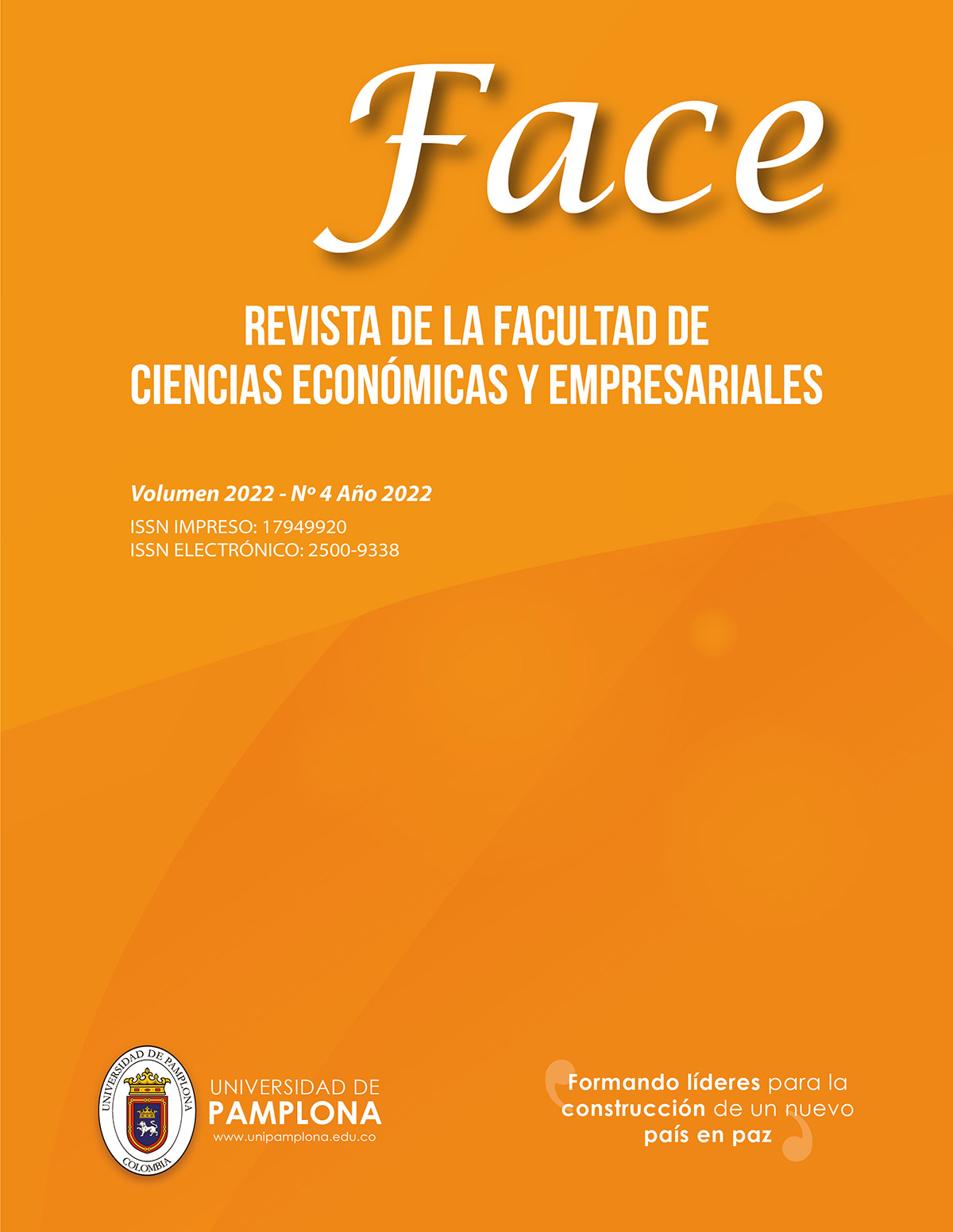La valuación del capital intelectual en el sector servicios de empresas mexicanas que cotizan en la bolsa mexicana de valores BMV 2014-2019
DOI:
https://doi.org/10.24054/face.v22i4.2293Palabras clave:
capital humano, servicios, capital intelectual, capital estructural y capital empleadoResumen
Hoy por hoy el conocimiento es la principal fuente en la creación y generación de ventaja competitiva y riqueza en las empresas. La gestión del capital intelectual es sinónimo de empresa competitiva empleándose en la construcción del modelo de gestión del conocimiento. Es por ello que en este artículo se ha identificado el impacto positivo que tienen el capital intelectual y sus componentes medidos a través del VAICTM, en variables de rendimiento financiero como la Rentabilidad sobre los Activos (ROA), la Rentabilidad sobre Fondos Propios (ROE) y la Productividad de los Empleados (TLP), de empresas del sector servicios que cotizan en la Bolsa Mexicana de Valores durante el periodo 2014 – 2019. El análisis de los datos nos permite observar que en específico el capital humano y el capital empleado son los indicadores que inciden en el desempeño financiero, así también el indicador de capital intelectual medido a través del VAICTM impacta positivamente en los resultados financieros de las organizaciones.
Descargas
Referencias
Becerra-Fernández, I. y Sabherwal, R. (2005), “Knowledge management at NASA-Kennedy Space Center”, en Int.J.Knowledge and Learning, vol. 1, núms. 1-2, pp.159-170.
Bolsa Mexicana de Valores BMV (2020). Listado de empresas emisoras. Información digitalizada. Informes anuales. Reportes anuales. [en línea], disponible en: www.bmv.com.mx
Bueno, E., Salmador, M., & Merino, C. (2008). Génesis, concepto y desarrollo del capital intelectual en la economía del conocimiento: Una reflexión sobre el Modelo Intellectus y sus aplicaciones. (Spanish). Estudios De Economía Aplicada, 26(2), 43-63.
Centro de Investigación y Documentación sobre problemas de la Economía, el Empleo y las Cualificaciones Profesionales CIDEC (2004). Gestión del conocimiento y capital intelectual. Número 31. Colección: cuadernos de trabajo -formación, empleo, cualificaciones-. Donostia-San Sebastián. Michelena Artes Gráficas S.L.
Darín, S. & González, Y. (2008). Nuevos paradigmas de la gestión en un cambio de época: de la era industrial a la era del conocimiento, los retos derivados de la globalización. (Spanish). Ciencias De La Información, 39(1), 53-58.
Davenport, T. y Prusak, L. (2001), “Know what you know” [en línea], disponible en: http://www.brint.com/km/daveport/cio/know.htm
Díaz, L. V. (2007). Gestión del conocimiento y del capital intelectual: una forma de migrar hacia empresas innovadoras, productivas y competitivas. Revista Escuela de Administración de Negocios, (61), 39-67.
Grant, R.M., 1991. The resource based theory of competitive advantage: implications for strategy formulation. California Management Review, 33(3), pp.114-135.
Joshi, M., Cahill, D., Sidhu, J. & Kansal, M. (2013).Intellectual capital and financial performance: an evaluation of the Australian financial sector. Journal of Intellectual Capital. Volume: 14 Issue: 2. pp.264 –285. Recuperado de: http://www.emeraldinsight.com/journals.htm?articleid=17088013
Kujansivu,P. & Lonnqvist, A. (2007), “Investigating the value and efficiency of intellectual capital”, Journal of Intellectual Capital, Vol. 8 No. 2, pp. 272-287.
Laing G., Dunn, J & Hughes-Lucas, S. (2010). Applying the VAIC™ model to Australian Hotels, Journal ofIntellectual Capital, 11(3), 269-283.
Mehri, M., Umar, M. S., Saeidi, P., Hekmat, R. K. y Naslmosavi, S. (2013). Intellectual capital and firm performance ofhigh intangible intensive industries: Malaysia evidence. Asian Social Science, 9(9), 146.
Molodchik, M. & Bykova, A. (2011). Applying the VAIC Model to Russian Industrial Enterprises. Proceedings Of The European Conference On Intellectual Capital, 268-277. Recuperado de: http://web.ebscohost.com/ehost/pdfviewer/pdfviewer?sid=a3d18d63-7a1e-4501-afe8-2997046cc781%40sessionmgr110&vid=4&hid=121
Mondal, A. & Ghosh, S. (2012). Intellectual capital and financial performance of Indian banks. Journal of Intellectual Capital. Vol. 13 Iss: 4, pp.515 –530. Recuperado de: http://www.emeraldinsight.com/journals.htm?articleid=17058735
Nonaka, I. (2000). “La empresa creadora de conocimiento”, en Gestión del conocimiento. Bilbao. Deusto.
Nonaka, I. y Takeuchi, H. (1999). La organización creadora de conocimiento: cómo las compañías japonesas crean la dinámica de lainnovación. México. Oxford University Press.
Ordóñez (2004). El capital estructural organizativo como fuente de competitividad empresarial. Recuperado de: www.minetur.gob.es/Publicaciones/.../357/13_PatriciaOrdonez_357
Prusak, L. (1997), Knowledge in organizations. Boston. Butterworth-Heinemann.
Pulic, A. (1998). Measuring the performance of intellectual potential in the knowledge economy. Recuperado de: www.measuring-ip.at.
Pulic, A. (2000). VAIC™ –an accounting tool for IC management. International Journal of Technology management, 20(5), 702-714. Recuperado de: http://resources.metapress.com/pdf-preview.axd?code=y2c0e45l6wb4a9lf&size=largest
Pulic, A. (2004), Intellectual capital –does it create or destroy value?, Measuring Business Excellence, Vol. 8 No. 1, pp. 62-8. Recuperado de: http://www.emeraldinsight.com/journals.htm?articleid=843767
Ross, S., Westerfield, R. y Jordan, B. (2014). Fundamentos de finanzas corporativas. México: Editorial McGraw Hill.
Sánchez, A., Melián, A. y Hormiga, E.(2007). El concepto de capital intelectual y sus dimensiones. Investigaciones Europeas de Dirección y Economía de las Empresas. Vol. 13, No 2, 2007, pp. 97-111. ISSN 1135-2523.
Statistical Package for the Social Sciences SPSS (2022). SPSS Software. Recuperado de: http://www-01.ibm.com/software/analytics/spss/
Sveiby, K-E. (2000). Capital intelectual. La nueva riqueza de las empresas. Maxima Laurent du Mesnil, Paris.
Sveiby, K-E. (2010). Methods for Measuring Intangible Assets. Copyright ©Karl-Erik Sveiby Jan 2001, updated 27 April 2010. All rights reserved. Recuperado de: http://www.sveiby.com/articles/IntangibleMethods.htm
Volkov, A. (2012). Value Added Intellectual Co-efficient (VAIC™): A Selective Thematic-Bibliography. Journal of New Business Ideas & Trends. 10(1), pp. 14-24.
Wah, S., Hang, K. & Wu, W. (2011). Charting intellectual capital performance of the gateway to China. Journal of Intellectual Capital, Vol. 12 Iss: 2, pp.249 –276.
Publicado
Número
Sección
Licencia
Derechos de autor 2023 FACE: Revista de la Facultad de Ciencias Económicas y Empresariales

Esta obra está bajo una licencia internacional Creative Commons Atribución-NoComercial-CompartirIgual 4.0.





